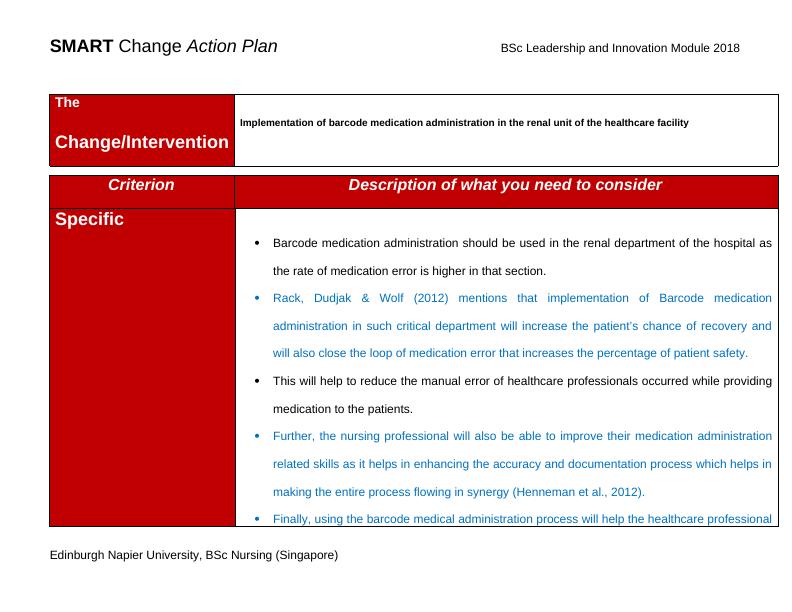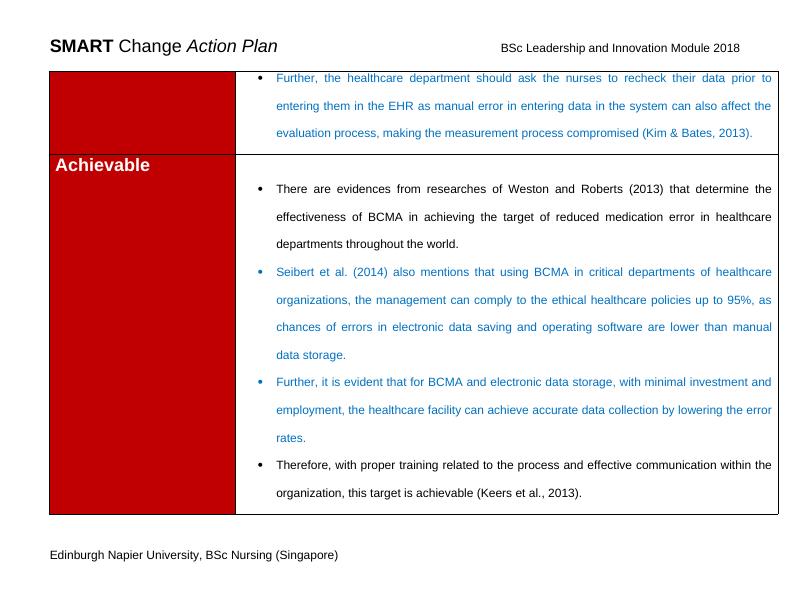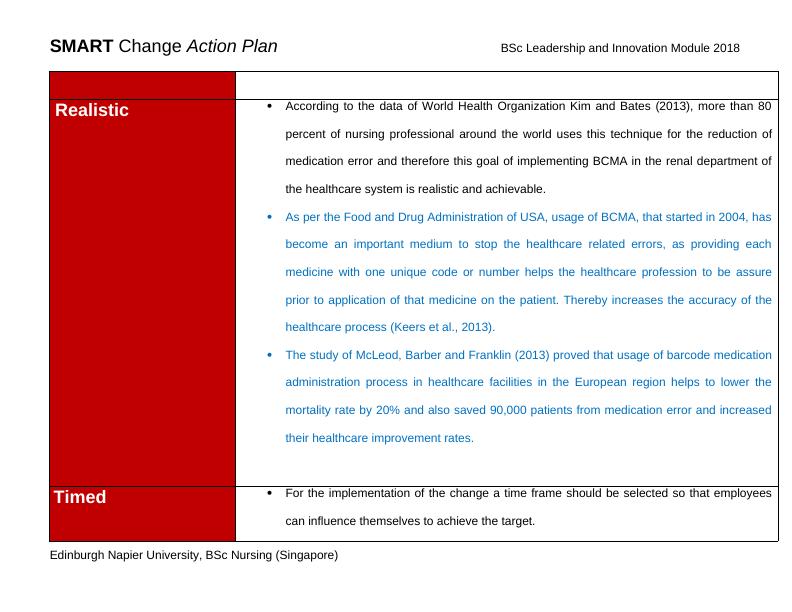Implementing Barcode Medication Administration in Renal Unit of Healthcare Facility
Added on 2023-06-10
12 Pages1648 Words349 Views
SMART Change Action Plan BSc Leadership and Innovation Module 2018
The
Change/Intervention
Implementation of barcode medication administration in the renal unit of the healthcare facility
Criterion Description of what you need to consider
Specific
Barcode medication administration should be used in the renal department of the hospital as
the rate of medication error is higher in that section.
Rack, Dudjak & Wolf (2012) mentions that implementation of Barcode medication
administration in such critical department will increase the patient’s chance of recovery and
will also close the loop of medication error that increases the percentage of patient safety.
This will help to reduce the manual error of healthcare professionals occurred while providing
medication to the patients.
Further, the nursing professional will also be able to improve their medication administration
related skills as it helps in enhancing the accuracy and documentation process which helps in
making the entire process flowing in synergy (Henneman et al., 2012).
Finally, using the barcode medical administration process will help the healthcare professional
Edinburgh Napier University, BSc Nursing (Singapore)
The
Change/Intervention
Implementation of barcode medication administration in the renal unit of the healthcare facility
Criterion Description of what you need to consider
Specific
Barcode medication administration should be used in the renal department of the hospital as
the rate of medication error is higher in that section.
Rack, Dudjak & Wolf (2012) mentions that implementation of Barcode medication
administration in such critical department will increase the patient’s chance of recovery and
will also close the loop of medication error that increases the percentage of patient safety.
This will help to reduce the manual error of healthcare professionals occurred while providing
medication to the patients.
Further, the nursing professional will also be able to improve their medication administration
related skills as it helps in enhancing the accuracy and documentation process which helps in
making the entire process flowing in synergy (Henneman et al., 2012).
Finally, using the barcode medical administration process will help the healthcare professional
Edinburgh Napier University, BSc Nursing (Singapore)

SMART Change Action Plan BSc Leadership and Innovation Module 2018
by providing the service users with five rights of medical administration that enhances the
quality of the healthcare process (Seibert et al., 2014).
Measurable
The measurement of the effectiveness of the BCMA will be done by carrying out the
evaluation of the medication records. For this purpose, the electronic data storage of the
records will be used so that by comparing the previous medication data error with the current
data, the percentage of decreased medication can be assessed (Nanji et al., 2016).
After the implementation, of the BCMA, primary evaluation will be done based on the number
of errors occurring within 1 week after implementation of changed process.
The evaluation will continue till the 6 month period of change implementation and all the shifts
will be included in the evaluation period so that the positive effect of BCMA on the nursing
practice can be understood (Keers et al., 2013).
For this purpose, the healthcare organization should use authentic electronic healthcare
record software so that after entering the data in the software, the authenticity of the data
remains intact.
Edinburgh Napier University, BSc Nursing (Singapore)
by providing the service users with five rights of medical administration that enhances the
quality of the healthcare process (Seibert et al., 2014).
Measurable
The measurement of the effectiveness of the BCMA will be done by carrying out the
evaluation of the medication records. For this purpose, the electronic data storage of the
records will be used so that by comparing the previous medication data error with the current
data, the percentage of decreased medication can be assessed (Nanji et al., 2016).
After the implementation, of the BCMA, primary evaluation will be done based on the number
of errors occurring within 1 week after implementation of changed process.
The evaluation will continue till the 6 month period of change implementation and all the shifts
will be included in the evaluation period so that the positive effect of BCMA on the nursing
practice can be understood (Keers et al., 2013).
For this purpose, the healthcare organization should use authentic electronic healthcare
record software so that after entering the data in the software, the authenticity of the data
remains intact.
Edinburgh Napier University, BSc Nursing (Singapore)

SMART Change Action Plan BSc Leadership and Innovation Module 2018
Further, the healthcare department should ask the nurses to recheck their data prior to
entering them in the EHR as manual error in entering data in the system can also affect the
evaluation process, making the measurement process compromised (Kim & Bates, 2013).
Achievable
There are evidences from researches of Weston and Roberts (2013) that determine the
effectiveness of BCMA in achieving the target of reduced medication error in healthcare
departments throughout the world.
Seibert et al. (2014) also mentions that using BCMA in critical departments of healthcare
organizations, the management can comply to the ethical healthcare policies up to 95%, as
chances of errors in electronic data saving and operating software are lower than manual
data storage.
Further, it is evident that for BCMA and electronic data storage, with minimal investment and
employment, the healthcare facility can achieve accurate data collection by lowering the error
rates.
Therefore, with proper training related to the process and effective communication within the
organization, this target is achievable (Keers et al., 2013).
Edinburgh Napier University, BSc Nursing (Singapore)
Further, the healthcare department should ask the nurses to recheck their data prior to
entering them in the EHR as manual error in entering data in the system can also affect the
evaluation process, making the measurement process compromised (Kim & Bates, 2013).
Achievable
There are evidences from researches of Weston and Roberts (2013) that determine the
effectiveness of BCMA in achieving the target of reduced medication error in healthcare
departments throughout the world.
Seibert et al. (2014) also mentions that using BCMA in critical departments of healthcare
organizations, the management can comply to the ethical healthcare policies up to 95%, as
chances of errors in electronic data saving and operating software are lower than manual
data storage.
Further, it is evident that for BCMA and electronic data storage, with minimal investment and
employment, the healthcare facility can achieve accurate data collection by lowering the error
rates.
Therefore, with proper training related to the process and effective communication within the
organization, this target is achievable (Keers et al., 2013).
Edinburgh Napier University, BSc Nursing (Singapore)

SMART Change Action Plan BSc Leadership and Innovation Module 2018
Realistic According to the data of World Health Organization Kim and Bates (2013), more than 80
percent of nursing professional around the world uses this technique for the reduction of
medication error and therefore this goal of implementing BCMA in the renal department of
the healthcare system is realistic and achievable.
As per the Food and Drug Administration of USA, usage of BCMA, that started in 2004, has
become an important medium to stop the healthcare related errors, as providing each
medicine with one unique code or number helps the healthcare profession to be assure
prior to application of that medicine on the patient. Thereby increases the accuracy of the
healthcare process (Keers et al., 2013).
The study of McLeod, Barber and Franklin (2013) proved that usage of barcode medication
administration process in healthcare facilities in the European region helps to lower the
mortality rate by 20% and also saved 90,000 patients from medication error and increased
their healthcare improvement rates.
Timed For the implementation of the change a time frame should be selected so that employees
can influence themselves to achieve the target.
Edinburgh Napier University, BSc Nursing (Singapore)
Realistic According to the data of World Health Organization Kim and Bates (2013), more than 80
percent of nursing professional around the world uses this technique for the reduction of
medication error and therefore this goal of implementing BCMA in the renal department of
the healthcare system is realistic and achievable.
As per the Food and Drug Administration of USA, usage of BCMA, that started in 2004, has
become an important medium to stop the healthcare related errors, as providing each
medicine with one unique code or number helps the healthcare profession to be assure
prior to application of that medicine on the patient. Thereby increases the accuracy of the
healthcare process (Keers et al., 2013).
The study of McLeod, Barber and Franklin (2013) proved that usage of barcode medication
administration process in healthcare facilities in the European region helps to lower the
mortality rate by 20% and also saved 90,000 patients from medication error and increased
their healthcare improvement rates.
Timed For the implementation of the change a time frame should be selected so that employees
can influence themselves to achieve the target.
Edinburgh Napier University, BSc Nursing (Singapore)

End of preview
Want to access all the pages? Upload your documents or become a member.
Related Documents
Change Action Plan BSc Leadership and Innovation Modulelg...
|2
|317
|297
Application of Barcode Medication Administration System at the Health Care Services in Singaporelg...
|1
|201
|57
Barcode Technology and Electronic Medication System in Healthcarelg...
|4
|1317
|116
Nursing Leadership and Innovation Assignmentlg...
|20
|5035
|88
Effectiveness of Barcode System in Reducing Medication Errorslg...
|10
|2035
|492
Change Management Implementation Planlg...
|5
|1090
|193
